Selecting the Best ICP Sample Introduction System
Special Issues
In this article, the author describes the components available for the "front end" of an inductively coupled plasma spectrometer and discusses the pros and cons of each.
There are many choices for components that constitute the "front end" of an inductively coupled plasma (ICP) spectrometer, including a number of developments over the past several years. In this article, the goal is to describe the options available and critique the pros and cons of each. In the end, the performance of the spectrometer depends upon the proper selection for each stage of the sample introduction system.
The sample introduction system includes all components involved in carrying the sample from the autosampler to the spectrometer, as shown in Figure 1.
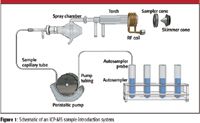
Figure 1
The following sections will address each component sequentially following the flow of sample through the system.
Autosampler Probe
The autosampler probe normally is prescribed by the specific brand and model of autosampler. However, there are a few considerations to bear in mind. The internal bore of the probe should be consistent and small to eliminate long fill and void times. It is best if the internal bore of the probe is continuous with the capillary attached to it to achieve laminar flow. Otherwise, pressure changes can occur and result in degassing of the sample, which can cause air bubbles to form in the sample line. Periodic release of air bubbles during integration can result in imprecision. Also, some autosampler probes are available with a built-in filter on the end to prevent particulates from reaching the nebulizer.
Peristaltic Pump Tubing
This compressible tubing is wrapped around the pump rollers, which when moving, push the sample (and waste) in the proper direction. There is a wide variety of tubing materials to choose from, and the choice depends upon the sample characteristics. Commonly used tubing materials include the following:
- PVC Standard; also known as Tygon ST (Saint-Gobain Corporation, Valley Forge, Pennsylvania). This is the least expensive tubing and is used for most aqueous samples.
- Solva; also known as Tygon HC or solvaflex. This is commonly used for petrochemicals, especially the measurement of wear metals in used engine oils (typically diluted in kerosene or xylene).
- TygonMH (Saint-Gobain). This is a special formulation of PVC that is more expensive than PVC Standard but stands up well to a wide variety of solvents.
- Fluran; also known as Viton (DuPont). Fluran is also a relatively expensive tubing material. It has often been used for organic solvents, but its strength is its resistance to strong acids and bases.
Table I is a general guide to help you choose the most suitable material. A more complete listing of tubing and compatibilities can be found elsewhere (1).

Table I: Compatibility of pump tubing material with various solvents
After you have decided on the tubing material, you must choose the proper internal diameter (i.d.), which is denoted by a universal color combination for the pump tags on the tubing (for example, two orange tags always indicate 0.89 mm i.d.). In combination with the pump size and speed, the tubing internal diameter determines the sample flow rate. As always, there are tradeoffs. Small internal diameter tubing combined with a higher pump speed is preferable to achieve a consistent signal with minimal pulsations from the rollers. On the other hand, the faster pump speed will cause the tubing to wear faster. One end of the pump tubing is connected to the autosampler probe and the other to the nebulizer capillary. It is sometimes difficult to insert the capillary into the end of the pump tubing if the internal diameter is small. If this is the case, flared-end tubing is available to facilitate installation. This is particularly important for the internal standard line if an in-line addition method is in use.
Nebulizer Capillary
The nebulizer capillary carries sample from the pump tubing to the nebulizer. Perfluoroalkoxy (PFA) and tetrafluoroethylene (TFE) are good choices for the material because they are "non-sticky" and available in high purity. To achieve fast washout times, both the length and the internal diameter of the tubing should be minimized as much as is practical.
Nebulizer
The nebulizer is one of the most critical components of the system. Its job is to convert the sample into a consistent and dense aerosol, one that is composed of small droplets. To select the most appropriate nebulizer for a specific application, you should consider a number of characteristics:
- Tolerance to total dissolved solids (TDS)
- Tolerance to particulates
- Tolerance to hydrofluoric acid (HF)
- Precision
- Transport efficiency
- Purity
- Robustness
Commonly employed nebulizers include the following:
- Cross-flow
- Concentric glass
- Concentric polymer
- Babington
- Ultrasonic
- Micro flow
The most commonly used nebulizer for both ICP-OES and ICP-MS is the concentric glass, so named because the sample line is concentric within the gas line. It delivers consistent aerosol and achieves high precision. The major drawback is its tendency to clog when running samples with particulates or high total dissolved solids. Advances in nebulizer design have clearly improved its tolerance to complex samples (Figure 2).
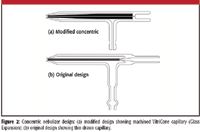
Figure 2
Cross-flow nebulizers are constructed so that the sample and gas lines meet at right angles. They were once commonly used but today are used primarily for samples containing hydrofluoric acid because of their inert construction. However, concentric polymer nebulizers are also compatible with HF and deliver excellent performance, thus explaining their growth in popularity.
Babington-style nebulizers include V-Groove nebulizers and function by pumping the sample over a gas orifice. This design can handle samples with very high salt content and even particulates. Unlike concentric nebulizers, Babington nebulizers are not self-aspirating and are therefore more susceptible to pump pulsations.
Ultrasonic nebulizers pump the sample onto an oscillating piezoelectric transducer, thereby increasing sample transport efficiency, usually in the range of 20% at 1-mL/min uptake rates (2). For clean samples, this can result in significant lowering of detection limits. One drawback is the high price tag. Also, their detection limit advantage is reduced greatly with complex samples because the matrix transport efficiency is increased as well.
Micro flow nebulizers are normally a subcategory of concentric nebulizers and operate at sample uptake rates well below 1 mL/min, typically in the range of 0.050 to 0.200 mL/min. Sample transport efficiencies at these low uptake rates equal or exceed those of ultrasonic nebulizers (3). These are a good choice when sample volume is limited or waste disposal is expensive (for example, radioactive).
Spray Chambers
The function of the spray chamber is to filter the aerosol produced by the nebulizer so that only the smallest droplets reach the plasma. The most commonly used spray chambers in plasma spectrometry are the cyclonic, barrel (or Scott type), and conical configurations (Figure 3).
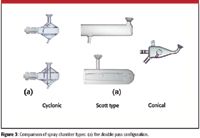
Figure 3
Notice that the cyclonic and Scott-style spray chambers are available as both single and double pass (or baffled) configurations. The double pass acts as a secondary filter, further reducing the mean droplet size. The conical spray chamber uses a built-in impact bead to create a finer mist. In all three designs, gravity is used to remove the larger droplets, which are then diverted to the drain. Only in the cyclonic design is centrifugal force also employed to remove the larger droplets, thus reducing re-nebulization and enhancing precision. For this and other reasons, cyclonic spray chambers have gained significantly in popularity. Cyclonic spray chambers are also available with reduced volumes to speed washout times when used with micro flow nebulizers. Both cyclonic and Scott-type chambers are commercially available with inert construction to accommodate HF.
For some applications, it is desirable to heat or chill the spray chamber or simply to prevent the temperature from varying (4). For these applications, the above spray chambers are available in jacketed configurations that allow an external supply to pump temperature-controlled liquid through the chamber housing. A more elegant solution is a standalone Peltier-driven device, which replaces the existing chamber. Examples of both of these are shown in Figure 4.
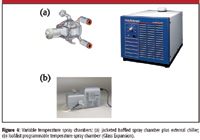
Figure 4
Torch
The function of the torch is to convert the sample aerosol into atoms or ions. This is accomplished by injecting the aerosol into a contained argon plasma, where desolvation, atomization, excitation, and ionization take place. All torches have at least three flows. The coolant gas is directed between the outer tube and intermediate tube and sheaths the outer tube from the plasma. Insufficient coolant flow will quickly destroy the torch. The auxiliary gas is directed between the intermediate tube and the injector. This flow is much lower and is used to control the height of the plasma above the injector. The sample itself (along with the nebulizer gas) goes through the injector tube and must achieve enough velocity to puncture the plasma without unduly decreasing the residence time of the atoms (or ions). There are three categories of torch design distinguished by the degree of demountability (Figure 5).
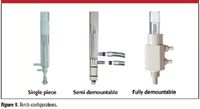
Figure 5
The single piece quartz torch is the general use torch and the least expensive with respect to initial investment. However, the torch must be completely replaced if any component is damaged and lacks versatility. The semi-demountable torch has a demountable injector, which allows different orifice size injectors to be installed without acquiring a new torch. For example, when analytes are in high salt matrices, a wider bore orifice reduces the likelihood of problematic salt buildup at the injector tip. Conversely, for organic solvents, a smaller-bore orifice reduces the plasma load. Also, the injector can be replaced with one made of a material other than quartz for specific applications, as follows:
- Ceramic (alumina): HF-containing samples
- Sapphire: ultrapure and HF applications
- Platinum: ultrapure applications
With a fully demountable torch, the outer and intermediate tubes (in addition to the injector) can be replaced individually, yielding a few advantages over semidemountable and single-piece torches. First, because the outer tube takes the most abuse, it deteriorates fastest. It is significantly less expensive to replace an outer tube than a whole torch. In addition, ceramic outer tubes are available as replacements. This is advantageous in applications where the outer tube degrades particularly rapidly, such as the determinations of wear metals in used engine oils and the analysis of very high TDS samples. In addition, some analysts prefer nonquartz outer tubes for the determination of ultratrace silicon.
RF Coil
The function of the RF coil is to initiate and sustain the plasma, thus imparting energy to the sample for efficient excitation and ionization. Energy emanates from the surface of the coil, so as the surface deteriorates, transfer efficiency degrades. The RF system should compensate for this but at the expense of the life of RF components and circuitry. As a coil surface deteriorates, replacement should be considered. The coil itself is a three- or four-turn hollow copper tube that is either water- or air-cooled. A variety of coatings are available. Coils are therefore available with the following configurations (Figure 6):
- Uncoated: a bare copper coil is the least expensive configuration but will require the most frequent replacement.
- Silver coated: silver is the most conductive coating and provides the most efficient energy transfer.
- Gold coated: gold is not as efficient a coating as silver, but it is more inert and is recommended for laboratories with particularly corrosive environments.
- Silver coated with PTFE sheath: for better chemical resistance, coils are available with a PTFE sheath in addition to the silver coating.
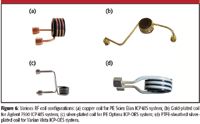
Figure 6
To achieve optimum performance and life from a torch, the user must ascertain that the torch is concentric within the coil. Otherwise, "hot spots" are likely to develop, which will damage the quartz outer tube prematurely. Alignment tools are often available from either the instrument manufacturer or the coil supplier to facilitate this task.
Interface Cones
This last component to be discussed applies only to inductively coupled plasma mass spectrometry (ICP-MS), where the metal interface cones extract the ions generated in the plasma, which are then directed into the spectrometer. To accomplish this, two interface cones are employed. The first, or sampler cone, is seated at the tail of the plasma, and the second, or skimmer cone, is situated right behind it. Needless to say, the sampler cone in particular takes quite a bit of abuse both from the intense heat and the sample matrix. An example of a pair of interface cones is shown in Figure 7.

Figure 7
Note that the skimmer cone is more pointed and smaller than the sampler, a common characteristic of all interface cones. The most common metal used for cones is nickel, sometimes alloyed with copper. For greater lifetimes, and some believe better performance, platinum cones are often a better choice. Platinum, being a noble metal, is more inert and hence less likely to react with the sample matrix. Platinum is also preferable if nickel is an analyte of interest. Another less expensive alternative if this is the case is to use aluminum cones. Pure platinum is never used for cones; it is always alloyed with another metal such as rhodium or iridium for hardness. Both of these metals (and especially rhodium) are also quite expensive. To compensate for the high price of platinum cones, some suppliers offer a no-charge lifetime refurbishment.
Summary
Many choices must be made to assemble the best sample introduction system for a given application. Typically, when a new instrument is delivered, it comes with a "universal" sample introduction system. Most likely, it is a proper sample introduction system only for aqueous samples that are relatively clean and do not contain HF. If your samples differ from that description, you should consider the options that have been described here.
Jerry Dulude is with Glass Expansion, Inc., Pocasset, Massachusetts.
References
(1) Ismatec SA, Chemical Resistance Properties of Tubing (2006), Switzerland.
(2) M.A. Tarr, G. Chu, and R.F. Browner, J. Anal. At. Spectrom. 7, 813–817 (1992).
(3) H. Liu, R.H. Clifford, S.P. Dolan, and A. Montaser, Spectrochim. Acta 51B, 27–40 (1996).
(4) J. Dulude, R. Stux, and V. Dolic, Pittcon, Paper # 1370 (2007).
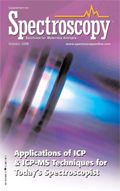
High-Speed Laser MS for Precise, Prep-Free Environmental Particle Tracking
April 21st 2025Scientists at Oak Ridge National Laboratory have demonstrated that a fast, laser-based mass spectrometry method—LA-ICP-TOF-MS—can accurately detect and identify airborne environmental particles, including toxic metal particles like ruthenium, without the need for complex sample preparation. The work offers a breakthrough in rapid, high-resolution analysis of environmental pollutants.
Trending on Spectroscopy: The Top Content of 2024
December 30th 2024In 2024, we launched multiple content series, covered major conferences, presented two awards, and continued our monthly Analytically Speaking episodes. Below, you'll find a selection of the most popular content from Spectroscopy over the past year.